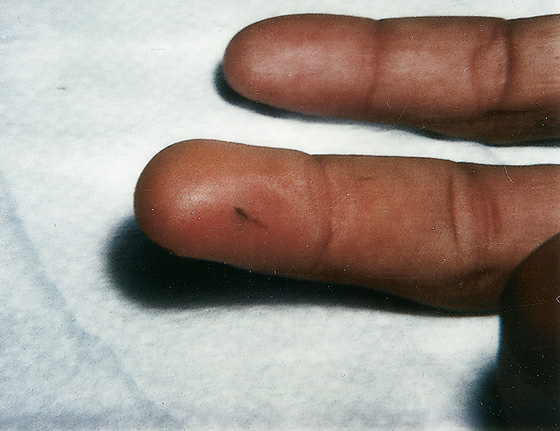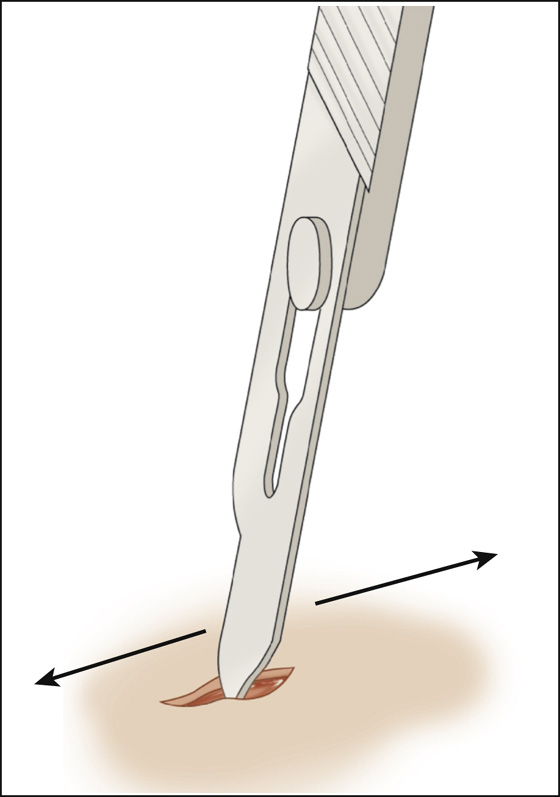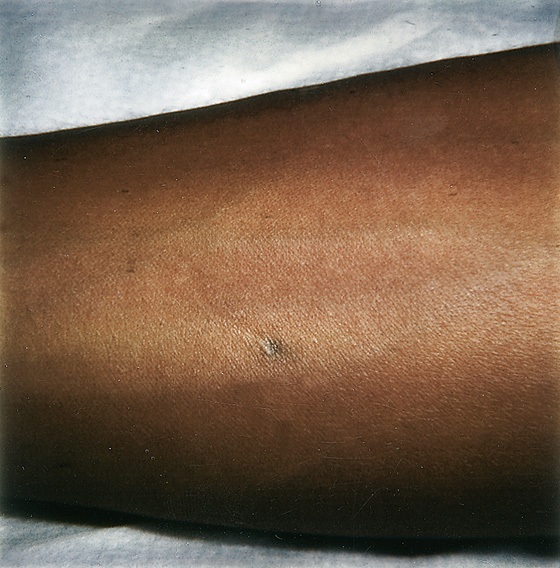CHAPTER 150
Pencil Point Puncture
Presentation
The patient presents after being stabbed or stuck with a sharp pencil point. He may be openly or unconsciously worried about lead poisoning. A small puncture wound lined with graphite tattooing will be present (Figure 150-1). The pencil tip may or may not be present, visible, or palpable. If the puncture wound is palpated, an underlying pencil point may give the patient a foreign body sensation.

Figure 150-1 Acute pencil point puncture.
What To Do:
 Reassure the patient or parent that there is no danger of lead poisoning. Pencil “leads” are made of clay and graphite, which is primarily carbon and nontoxic.
Reassure the patient or parent that there is no danger of lead poisoning. Pencil “leads” are made of clay and graphite, which is primarily carbon and nontoxic.
 Conduct a full examination, including sensory and motor function of the affected area.
Conduct a full examination, including sensory and motor function of the affected area.
 Obtain a thorough history relating to the injury, and assess the patient’s risk of developing complications, which are rare.
Obtain a thorough history relating to the injury, and assess the patient’s risk of developing complications, which are rare.
 Palpate and inspect for a foreign body. If uncertain, obtain a radiograph or ultrasonogram to rule out the presence of a foreign body. Most often, there is no foreign body; there are only the embedded black graphite particles.
Palpate and inspect for a foreign body. If uncertain, obtain a radiograph or ultrasonogram to rule out the presence of a foreign body. Most often, there is no foreign body; there are only the embedded black graphite particles.
 Administer local anesthesia if necessary; then thoroughly scrub the wound.
Administer local anesthesia if necessary; then thoroughly scrub the wound.

 To reduce the amount of tattooing, the wound may be scraped (dermabraded) with the tip of a scalpel blade (Figure 150-2). Always administer local anesthesia using lidocaine (1% with or without epinephrine) before scraping wound.
To reduce the amount of tattooing, the wound may be scraped (dermabraded) with the tip of a scalpel blade (Figure 150-2). Always administer local anesthesia using lidocaine (1% with or without epinephrine) before scraping wound.

Figure 150-2 Dermabrade to reduce tattooing.
 Warn the patient or family about signs of infection (increasing pain, redness, swelling, red streaking,) and inform them that there may be a permanent black tattoo that can be removed later if the resulting mark is cosmetically unacceptable (Figure 150-3).
Warn the patient or family about signs of infection (increasing pain, redness, swelling, red streaking,) and inform them that there may be a permanent black tattoo that can be removed later if the resulting mark is cosmetically unacceptable (Figure 150-3).

Figure 150-3 Residual tattoo from old pencil point puncture.
 Administer tetanus prophylaxis, if necessary (see Appendix H).
Administer tetanus prophylaxis, if necessary (see Appendix H).
What Not To Do:
 Do not excise the entire wound on the initial visit.
Do not excise the entire wound on the initial visit.
 Do not prescribe prophylactic antibiotics, because these are not necessary.
Do not prescribe prophylactic antibiotics, because these are not necessary.
Discussion
It is unwise to excise the entire wound, because the resultant scar might be more unsightly than the tattoo. If a superficial pencil tip foreign body exists, see Chapter 154 for an easy removal technique. Most of these wounds do not contain a foreign body but only the appearance of one. Tattoo prevention should be the clinician’s primary concern. If tattooing is present and of cosmetic concern, the patient may benefit from a referral to a dermatologist for removal.
Rarely, deep punctures or foreign bodies may require exploratory surgery in the operating room.

Full access? Get Clinical Tree



